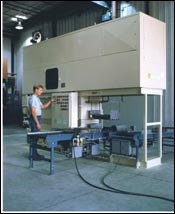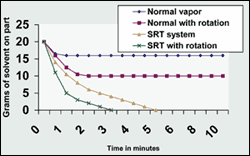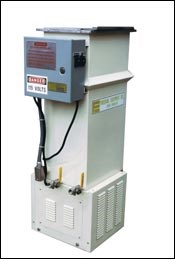Still Valuable
Vapor degreasing remains the cleaning process of choice in some applications
Vapor degreasing has been around a long time. Originating in Europe, the process was brought to the U.S. in the 1930s. Trichloroethylene (TCE) and perchloroethylene (PCE) were the original solvents used. Both are very good, non-flammable solvents that penetrate into small holes, crevices, and seams in parts.
Both solvents have heavy vapor (4.3 and 6.0× heavier than air, respectively) that allows not only the liquid but also the vapor to be contained in a tank. This allowed cleaning by boiling liquid solvent in the bottom of a tank to generate a solid column of heavy vapors. A condensing system, properly positioned at an upper level in the tank, condensed the solvent vapors at a rate equal to vapor formation.
Vapor degreasing offered an excellent way to clean the oils and fats used extensively in machining, stamping and drawing operations, and had distinct advantages over common soap cleaning processes for these types of soils. Unfortunately, the recent history of vapor degreasing in the U.S. has revolved around increasing regulation and outright banning of some solvents.
For example, another commonly used solvent was methylene chloride (MC). It operated at 104°F, and was very successful in proper equipment. Its big advantage was a significant energy savings versus PCE and TCE. Unfortunately, MC usage was largely eliminated when the Occupational Safety and Health Administration (OSHA) lowered exposure limits from 550 ppm to 12.5 ppm.
Proprietary processes were also available. An example was a patented process called Cool Phos, which cleaned and phosphated steel parts in one step. It was very successful and there were many users. Proper equipment was essential.
When California outlawed TCE in 1966, another solvent, 1-1-1 Trichloroethane (TCA) gained wide acceptance. With the exception of its insolubility and a tendency to decompose to form hydrochloric acid, it was a good, non-flammable degreasing solvent. A stabilizer could prevent acid formation.
Freon (CFC 113), developed by Dupont, was an outstanding vapor degreasing solvent with good stability and ability to clean most plastic parts and electronic assemblies without damage. The discovery of an “ozone hole” brought an end to use of both CFC 113 and TCA in the U.S. Currently, TCA and CFCs are banned. TCE, PCE, and MC can still be used but are subject to strict emissions and safety guidelines.
Current Regulations
The Clean Air Act of 1990 placed TCE, PCE, TCA, Freon, and MC on a list of some 189 hazardous air pollutants. In national emission standards for hazardous air pollutants (NESHAP) rule proposed in 1984, EPA tested two major control devices. These were the refrigerated freeboard devices and carbon absorption systems. Neither of these controls addressed the major causes of solvent loss—air movement and drag-out—and the proposal was withdrawn. Unfortunately, the proposed rule was adopted by many states, and many degreaser designs were accordingly approved.
These controls did, however, have the effect of addressing the large amounts of solvent loss caused by poor machine design. Problems that lead to excessive solvent loss include:
- Inadequate condensing coils
- No condensate trough
- Poor water separators
- Inadequate freeboard
- Excessive exhaust air
- Fluctuating vapor line.
Early OSHA rules on degreasers also condoned bad practices. They required 50% freeboard and allowed excessive exhaust, when the idea should have been to keep the solvent in the machine. So many machines permitted or condoned by the government using much more solvent than the original earlier designed machines.
Newer, more efficient machines have since replaced these poor machines, and many users have adopted other means of cleaning. Sometimes, potential users of vapor degreasing technology chose alternate cleaning methods primarily because of permitting and reporting requirements of the NESHAP rule.
These requirements are complex, confusing and often misunderstood. Large, unwarranted fines were not uncommon, with the resulting negative publicity. The demise of TCA and CFC 113 was a serious blow to vapor degreasing, but things do change.
Current Technology
Vapor degreasing is still a viable process, and in some applications it is nearly indispensable. But the simple vapor degreaser described earlier is no longer acceptable; today’s vapor degreasers are anything but simple machines.
The main focus of evolving vapor degreasing technology has been eliminating solvent emissions. The first task in minimizing loss of solvent was understanding what really caused the loss of solvent.
Solvent manufacturers as well as regulators such as the U.S. Environmental Protection Agency (EPA) did not believe the cause of losses could be measured or determined in advanced. Their belief was that all losses were simply “fugitive.” Our company did not believe this, and we spent a large amount of time and effort measuring losses from different parts, cycle times, air movements, and other variables.
These tests resulted in our development of our Solvent Recovery Treatment (SRT) process. This technology uses “super heat” to facilitate removal and recovery of all liquid solvent that is used on parts to eliminate drag out. Referred to by other suppliers in the industry as “passive” or “static” super heat, it consists of the ability to heat the parts above the solvent boiling point and therefore remove all solvent from the parts before they exit the vapor zone. In recent projects where existing systems employing older technology were replaced with Finishing Equipment degreasers, solvent consumption was reduced by 80%.
After first tackling these relatively large sources of solvent loss, we and other companies began trying to address the less significant sources. There were quite a number of new solvents suggested for vapor degreasing, and so-called vacuum degreasing technology received a lot of publicity. Extensively used in Japan and Germany, vacuum degreasing has been around for about 40 years.
Theoretically, vacuum vapor degreasing looks good. In use, the theoretical advantages have not lived up to their promise. Why? There are several reasons:
- The process tends to be slow and not productive
- Maintenance and operation are labor-intensive
- Vacuum cleaning is often not adequate
- Equipment cost is very high
- Solvent stability problems are often and serious
Finishing Equipment looked seriously at vacuum machines on two different occasions, once about thirty years ago and again about ten years ago. Our company continues to study these designs and ways to eliminate their shortcomings.
New solvents available for vapor degreaser use include N-propyl bromide, which is similar to TCE in effectiveness and results with proper control and stabilizer additions. Vertrel, from Dupont, is a halogenated fluorocarbon that is safe and stable. Several blends are available. There are many other solvents that certainly work well in modern vapor degreasers, and can do so economically while meeting all environmental and worker safety rules when used with proper equipment.
Vapor Degreasing Advantages
Vapor degreasing became widely used in short order because it fulfilled the two fundamental requirements of effective cleaning in one simple process. These requirements, of course, are that the process must be capable of removing the soils from the parts to be cleaned, and that the last fluid the parts see must be pure enough to leave minimal or no residue. A vapor degreaser is still the only cleaning system which can provide distilled cleaning fluid as part of the normal cleaning cycle.
In this era of rising energy costs, one of the main advantages of a vapor degreasing solvent and system versus an aqueous cleaning system is lower energy consumption. Compared with aqueous systems, a vapor degreaser typically uses 1/5 the energy for heat-up and 1/7 the amount for drying.
In one example, a plant in Mexico running hundreds of aluminum copper coils per hour operates a heat recovery system supplied by our company. The system meets the facility’s total heating and cooling requirements. Vapor degreaser energy cost is about $5 per hour, versus $75 per hour for an aqueous system which would not clean the parts as well. Calculated on a 24/7 basis, the energy savings alone amounts to more than $600,000 annually.
Vapor degreasing also provides superior cleaning for many parts and assemblies, including:
- Small and/or intricate machine parts.
- Spot free cleaning.
- Cleaning between laps, seams, spot welds, prior to powder, or other coating.
- Cleaning parts prior to electroplating cycles.
- Removing buffing compound
- Tubing
- Prior to soldering, brazing and welding
- Prior to vacuum brazing
- Plastic polishing
Some applications simply require the ability of vapor degreasing to provide critically clean surfaces. One such application where vapor degreasing’s superior cleaning ability can literally be a matter of life and death is in cleaning aircraft parts in preparation for dye penetrant inspection. For about 60 years, vapor degreasing was accepted as the best technology for this application, but the fear of solvents caused some overhaul operation to change cleaning methods.
Aircraft accidents resulting in many deaths resulted from that change. Fortunately, most aircraft overhaul facilities continued to use vapor degreasing, which enabled them to find fatigue cracks and other minor defects that can compromise safety.
Another example of the ability of vapor degreasing to provide critical cleaning that other processes cannot match came at the expense of the medical industry—and of some 40,000 patients who required hip or knee implants. Their suffering was apparently due to the elimination of vapor degreasing in the implant cleaning cycle. The result was a hard lesson learned and a billion dollar cost to the medical industry.
Related Content
Henry Ford Is Still Right When It Comes to Color
Who would have imagined that more than 100 years after his famous statement about any color as long as it’s black would still have relevance of a sort?
Read MoreMasking Solutions Provider CFS Dramatically Expands Capabilities and Capacity
Custom Fabrication & Supplies (CFS) completed a new plant expansion packing 10 times the capacity into twice the space. It dramatically enhances the supplier’s custom capabilities to provide extremely precise and cost-effective masking solutions.
Read MoreFinishing Systems Provider Celebrates 150 Years, Looks to Future
From humble beginnings as an Indiana-based tin shop, Koch Finishing Systems has evolved into one of the most trusted finishing equipment providers in the industry.
Read MoreTTX’s Automated Conveyor Carrier System Offers Wireless, Flexible Operation
ACC system designed for reliable, consistent point-to-point movement of everything from small to heavy parts.
Read MoreRead Next
A ‘Clean’ Agenda Offers Unique Presentations in Chicago
The 2024 Parts Cleaning Conference, co-located with the International Manufacturing Technology Show, includes presentations by several speakers who are new to the conference and topics that have not been covered in past editions of this event.
Read MoreEpisode 45: An Interview with Chandler Mancuso, MacDermid Envio Solutions
Chandler Mancuso, technical director with MacDermid Envio discusses updating your wastewater treatment system and implementing materials recycling solutions to increase efficiencies, control costs and reduce environmental impact.
Read MoreEducation Bringing Cleaning to Machining
Debuting new speakers and cleaning technology content during this half-day workshop co-located with IMTS 2024.
Read More















.jpg;maxWidth=300;quality=90)









